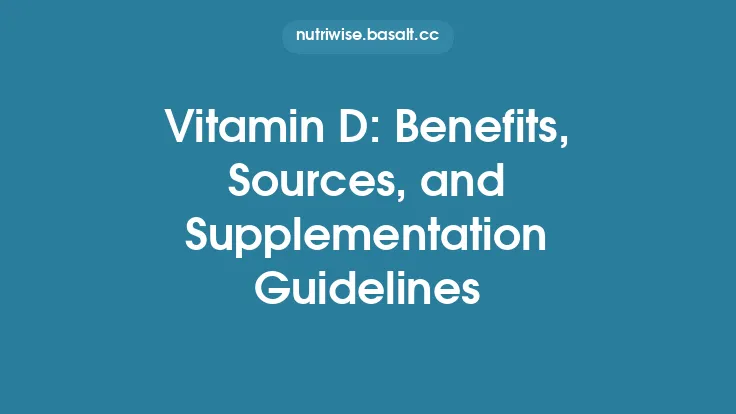Vitamin D is a fat‑soluble micronutrient that plays a pivotal role far beyond bone health. Its influence on the cardiovascular system, particularly on blood pressure regulation, has prompted clinicians to examine how vitamin D status and supplementation intersect with antihypertensive therapy. Understanding these interactions is essential for optimizing treatment outcomes, minimizing adverse effects, and ensuring that patients receive the full benefit of both their medication regimen and their micronutrient intake.
Physiology of Vitamin D in Blood Pressure Regulation
- Renin–Angiotensin–Aldosterone System (RAAS) Modulation
- Active vitamin D (1,25‑dihydroxyvitamin D) suppresses renin gene expression in the juxtaglomerular cells of the kidney.
- Lower renin levels translate into reduced angiotensin II formation, which can diminish vasoconstriction and sodium retention.
- Endothelial Function and Nitric Oxide Production
- Vitamin D receptors (VDR) are expressed on endothelial cells. Activation of VDR enhances endothelial nitric oxide synthase (eNOS) activity, promoting vasodilation.
- Deficiency is associated with endothelial dysfunction, a known precursor to hypertension.
- Inflammation and Fibrosis
- Vitamin D exerts anti‑inflammatory effects by inhibiting NF‑κB signaling.
- It also attenuates myocardial and vascular fibrosis through regulation of transforming growth factor‑β (TGF‑β) pathways.
- Calcium Homeostasis (Brief Note)
- While vitamin D increases intestinal calcium absorption, its impact on blood pressure is largely mediated through the mechanisms above rather than direct calcium loading. Clinicians should be aware of this when patients are on diuretics that affect calcium handling, but the primary focus remains on the VDR‑mediated pathways.
Overview of Common Antihypertensive Classes
| Class | Primary Mechanism | Typical Agents |
|---|---|---|
| ACE Inhibitors | Block conversion of angiotensin I to angiotensin II | Lisinopril, Enalapril |
| Angiotensin II Receptor Blockers (ARBs) | Prevent angiotensin II from binding to AT₁ receptors | Losartan, Valsartan |
| Thiazide Diuretics | Inhibit Na⁺/Cl⁻ cotransporter in distal tubule → natriuresis | Hydrochlorothiazide, Chlorthalidone |
| Calcium‑Channel Blockers (CCBs) | Inhibit L‑type calcium channels → vasodilation | Amlodipine, Diltiazem |
| Beta‑Blockers | Reduce cardiac output and renin release | Metoprolol, Carvedilol |
| Mineralocorticoid Receptor Antagonists | Block aldosterone‑mediated sodium retention | Spironolactone, Eplerenone |
Each class interacts with the RAAS, sodium balance, or vascular tone—pathways that vitamin D also influences.
Potential Interactions and Clinical Implications
1. Synergistic RAAS Suppression
- ACE Inhibitors / ARBs + Vitamin D
- Vitamin D’s down‑regulation of renin may augment the blood‑pressure‑lowering effect of ACE inhibitors or ARBs.
- In patients with low baseline vitamin D, supplementation can lead to a modest additional reduction in systolic/diastolic pressure (≈2–5 mm Hg in meta‑analyses).
- Clinical tip: Monitor for excessive hypotension, especially after initiating high‑dose vitamin D (≥4,000 IU/day) in patients already well‑controlled on RAAS blockers.
2. Influence on Diuretic‑Induced Electrolyte Shifts
- Thiazide Diuretics
- Thiazides increase calcium reabsorption in the distal tubule. When combined with vitamin D–enhanced calcium absorption, there is a theoretical risk of hypercalcemia, though this is uncommon in patients with normal renal function.
- More relevant is the effect on serum potassium; vitamin D does not directly alter potassium handling, but clinicians should continue routine electrolyte monitoring.
3. Interaction with Calcium‑Channel Blockers
- Vitamin D does not directly affect the pharmacokinetics of CCBs. However, improved endothelial function from adequate vitamin D status may complement the vasodilatory action of CCBs, potentially allowing for lower drug doses.
4. Beta‑Blockers and Renin Secretion
- Beta‑blockers already suppress renin release. Adding vitamin D may produce a ceiling effect, with little additional impact on renin levels. The primary concern remains hypotension in patients with already low baseline blood pressure.
5. Mineralocorticoid Receptor Antagonists
- Spironolactone and eplerenone counteract aldosterone‑mediated sodium retention. Vitamin D’s anti‑fibrotic and anti‑inflammatory actions may synergize, especially in patients with resistant hypertension linked to vascular remodeling.
Monitoring Strategies and Laboratory Assessments
| Parameter | Frequency | Rationale |
|---|---|---|
| Serum 25‑hydroxyvitamin D | Baseline, then 3–6 months after initiating supplementation | Ensures target levels (30–50 ng/mL) are achieved without excess |
| Blood Pressure | Every visit (or home monitoring) | Detect additive hypotensive effects early |
| Serum Calcium & Creatinine | Baseline, then 1–2 months after high‑dose vitamin D (>4,000 IU) | Guard against hypercalcemia and renal impairment |
| Electrolytes (Na⁺, K⁺) | Routine for patients on thiazides or MRAs | Identify diuretic‑related shifts |
| Renin & Aldosterone (optional) | In research or refractory cases | Evaluate mechanistic impact of vitamin D on RAAS |
When adjusting therapy, consider a stepwise approach: first optimize vitamin D status, then reassess blood pressure and medication doses.
Practical Recommendations for Patients and Clinicians
- Assess Baseline Vitamin D Status
- Order a serum 25‑OH vitamin D test before initiating supplementation, especially in patients with hypertension, limited sun exposure, or malabsorption.
- Select an Appropriate Supplement Dose
- For most adults, 1,000–2,000 IU/day is sufficient to raise levels into the optimal range.
- Higher doses (4,000–10,000 IU/day) may be used under supervision for severe deficiency, but require close monitoring.
- Timing with Medications
- Vitamin D is best taken with a meal containing fat to enhance absorption.
- There is no need to separate it from antihypertensive pills; however, if a patient experiences dizziness after a dose change, spacing the supplement by a few hours can help isolate the cause.
- Educate on Symptoms of Over‑Supplementation
- Nausea, polyuria, weakness, and confusion may signal hypercalcemia. Prompt evaluation is warranted.
- Integrate Lifestyle Measures
- Encourage moderate sun exposure (10–15 minutes of midday sun on arms/legs, 2–3 times per week) and a diet rich in vitamin D–containing foods (fatty fish, fortified dairy, egg yolk).
- Document and Communicate
- Record vitamin D levels, supplement dose, and any blood pressure changes in the medical record. Share this information with pharmacists and other members of the care team.
Special Populations and Considerations
| Population | Key Points |
|---|---|
| Elderly | Reduced skin synthesis; higher prevalence of deficiency; monitor for falls if hypotension becomes pronounced. |
| Chronic Kidney Disease (CKD) | Impaired conversion to active 1,25‑(OH)₂D; may require active vitamin D analogs (calcitriol) rather than cholecalciferol. Interaction with ACE inhibitors/ARBs is especially relevant due to altered RAAS activity. |
| Black and Asian Individuals | Higher risk of deficiency due to melanin‑mediated UV absorption; consider earlier supplementation. |
| Pregnant Women with Hypertension | Vitamin D supplementation is generally safe up to 4,000 IU/day; monitor calcium and renal function closely. |
| Patients on Polypharmacy | Review for other agents that affect calcium or phosphate metabolism to avoid cumulative effects. |
Summary and Take‑Home Points
- Vitamin D influences blood pressure primarily through renin suppression, endothelial nitric oxide production, and anti‑inflammatory pathways.
- When combined with RAAS‑targeting antihypertensives (ACE inhibitors, ARBs, MRAs), adequate vitamin D status can provide an additive blood‑pressure‑lowering effect, but clinicians should watch for excessive hypotension.
- Thiazide diuretics may modestly increase calcium reabsorption; while vitamin D‑induced calcium absorption rarely leads to hypercalcemia, routine monitoring of serum calcium and renal function is prudent when high‑dose vitamin D is used.
- Routine assessment of serum 25‑OH vitamin D, blood pressure, electrolytes, and calcium is essential for safe, coordinated care.
- Patient education on proper supplement timing, potential side effects, and lifestyle measures enhances adherence and therapeutic success.
By integrating vitamin D evaluation into the management plan for hypertension, clinicians can address a modifiable factor that supports cardiovascular health while ensuring that medication regimens remain safe and effective.





